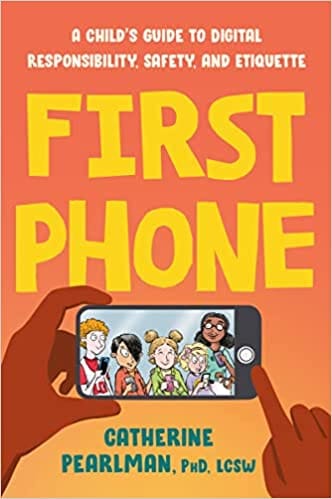WELCOME TO MIDLAND BOOK SHOP!
SHOP FOR
-
Contemporary Fiction
- Contemporary Fiction
-
Children
- Children
-
Comics & Graphic Novels
- Comics & Graphic Novels
-
Non-Fiction
- Non-Fiction
-
Fiction
- Fiction
Shop No.20, Aurobindo Palace Market, Hauz Khas, Near Church +91 9818282497 | 011 26867121
110016
New Delhi
IN
Midland The Book Shop ™
Shop No.20, Aurobindo Palace Market, Hauz Khas, Near Church +91 9818282497 | 011 26867121
New Delhi,
IN
+919871604786
https://www.midlandbookshop.com/s/607fe93d7eafcac1f2c73ea4/6468e33c3c35585403eee048/without-tag-line-480x480.png"
[email protected]
9780593538333
639333b3762b6efcbfcce489
First Phone A Childs Guide To Digital Responsibility, Safety, And Etiquette
https://www.midlandbookshop.com/s/607fe93d7eafcac1f2c73ea4/639333b4762b6efcbfcce4a2/41y8iyt4-1l-_sx330_bo1-204-203-200_.jpg
9780593538333
A fun and informative illustrated kids’ guide to safely and productively navigating the digital landscape.
Cellphones have become a fact of life, with children as young as eight (yes, eight!) getting their very own “devices.” Such boundless access means our kids are in nearly constant contact with technology that was designed specifically for adults. And they’re doing so without any type of road map. Enter First Phone: the essential book that apprehensive parents can confidently hand to their kids to read as they begin their journey into the digital world.
In First Phone, Catherine Pearlman—licensed clinical social worker and parenting expert—speaks directly to eight- to twelve-year-old children about digital safety in a manner that is playful, engaging, and age-appropriate. With insights and strategies supported by the latest research, First Phone offers:
• guidance on privacy, boundaries, social media, and even sexting (yes, young children need to learn about sexting before it happens!)
• best digital hygiene and self-care practices, including when to put the darn phone down, when to turn off notifications, and where to charge
• how to be a kind and compassionate upstander in a digital world
An essential companion when your child receives their first phone, this book provides kids the tools and information they need while giving their parents peace of mind.
Cellphones have become a fact of life, with children as young as eight (yes, eight!) getting their very own “devices.” Such boundless access means our kids are in nearly constant contact with technology that was designed specifically for adults. And they’re doing so without any type of road map. Enter First Phone: the essential book that apprehensive parents can confidently hand to their kids to read as they begin their journey into the digital world.
In First Phone, Catherine Pearlman—licensed clinical social worker and parenting expert—speaks directly to eight- to twelve-year-old children about digital safety in a manner that is playful, engaging, and age-appropriate. With insights and strategies supported by the latest research, First Phone offers:
• guidance on privacy, boundaries, social media, and even sexting (yes, young children need to learn about sexting before it happens!)
• best digital hygiene and self-care practices, including when to put the darn phone down, when to turn off notifications, and where to charge
• how to be a kind and compassionate upstander in a digital world
An essential companion when your child receives their first phone, this book provides kids the tools and information they need while giving their parents peace of mind.
Review
“Kids will want to read First Phone because it’s an informative, relatable guide. Parents will also be supported with a road map to discuss crucial issues with their children.”
—Devorah Heitner, PhD, author of Screenwise: Helping Kids Thrive (and Survive) in Their Digital World
“Catherine Pearlman talks about phone use—including the pleasures, the perils, and the pitfalls—with zero drama, tons of compassion, and a light touch. This is an invaluable resource for kids and parents both.”
—Catherine Newman, author of What Can I Say? A Kid's Guide to Super-Useful Social Skills to Help You Get Along and Express Yourself
—Devorah Heitner, PhD, author of Screenwise: Helping Kids Thrive (and Survive) in Their Digital World
“Catherine Pearlman talks about phone use—including the pleasures, the perils, and the pitfalls—with zero drama, tons of compassion, and a light touch. This is an invaluable resource for kids and parents both.”
—Catherine Newman, author of What Can I Say? A Kid's Guide to Super-Useful Social Skills to Help You Get Along and Express Yourself
About the Author
Dr. Catherine Pearlman, the founder of The Family Coach®, is a licensed clinical social worker who has been working with children and families for more than twenty-five years. She holds a Ph.D. in social welfare from Yeshiva University and a master’s of social work from New York University. Dr. Pearlman is also currently an associate professor of social work at University of Massachusetts Global. She is also the author of Ignore It!: How Selectively Looking the Other Way Can Decrease Behavioral Problems and Increase Parenting Satisfaction (TarcherPerigee, 2017).
Excerpt. © Reprinted by permission. All rights reserved.
CHAPTER 1
Who Needs Rules?
Back when my son, Emmett, was in third grade, he had a wonderful teacher named Mrs. Boys. If a student raised their hand to ask to go to the bathroom or to sharpen a pencil or to grab a book off the shelf, Mrs. Boys would respond with three magical words: Solve your problem.
Yes-solve your problem.
You see, Mrs. Boys knew two important secrets:
1. Kids are capable of making smart choices.
2. Kids learn more skills when they solve their own problems.
As an expert in child development, I couldn't agree more with Mrs. Boys. When children are able to make their own decisions based upon accurate information, they tend to go with better choices in the future.
So, what does solve your problem have to do with cell phones? Well, just about everything. Your parents will help monitor your actions on your smartphone. That is good because it takes time to learn how to be safe and kind in a digital world. Even adults have to keep learning about changes on the internet, with social media and privacy settings. However, there is no way your parents can prevent you from making some big mistakes. They will not be with you on the bus to school. They will not be with you when you are at your best friend's house. Even with controls set up for your safety, there will be millions of decisions you will have to make on your own.
In other words, you (and only you) will have to make good choices. I am certain you can make them, because you are smart and capable when given the facts. This book will help by teaching you what you need to know.
Caring for Your New Phone
Smartphones can be an expensive investment. What that means is, they cost a lot of money, so you should try to take good care of your phone. There are a few ways to make sure your phone stays safe.
Max: "Have one place you put your phone when it is in your backpack. That way you always know where it is."
Jack: "Buy a good case. I picked out a really cool case-it was neon green with a sick alligator. But my parents made me get a boring one because they said it was 'drop proof with screen protection.' 'Whatever,' I said. Well, I drop my phone a lot. Don't tell my parents, but they were right. I need the toughest case."
Benni: "Oh, and check all of your pockets before jumping in a pool. My cousin made this mistake. Twice."
Try to have a routine for where your phone goes at different parts of your day. Think about where to put it after school and where to charge it. If you always put it in the same place, it is more difficult to lose.
Phone Etiquette
Before we get into some of the more difficult topics, let's start with something fun-phone etiquette. Now, I know "etiquette" sounds sorta fancy and snobby, not unlike the French word for snails (that'd be escargot-and they're slimy and icky). But "etiquette" is just another way of saying, "Hey, use your manners." And knowing when to answer your phone or respond to a text (and when to ignore it for a little while) usually depends on etiquette.
Sofia: "Here's an important tip: When your parents call, always answer the phone (unless you are in the bathroom. In that case, call them right back when you finish)."
It is very normal to want to look at your phone when it buzzes. But it isn't always a good idea to do so. Let's say Grandma is visiting from Florida and you and your family are at dinner. Maybe you're all eating hamburgers, and Grandma is telling a story about when her best friend in high school quit the knitting club. Then-your phone pings! I know it can be tempting, but taking time to look at your device might make Grandma feel like you don't even care that she is there. (Grandparents aren't really down with the "I'd love to listen to you, but Samantha just DMed me a photo of her new kitten and it's so cute" excuse.) It often hurts people's feelings when it seems like your phone gets all your focus. And nothing makes parents madder than when they are asking for your attention but you keep looking at your phone. Trust me on this. I'm a parent.
Also, there are some places it's just unthoughtful to take a call. Imagine you're in the movie theater, and Thor is about to soar into the air, break out his hammer, and go after Loki, and you've been waiting for this moment for the last hour, and suddenly-BLEEP! BLEEP! BLEEP! BLEEP! BLEEP!-the phone belonging to the person behind you starts to ring. And then the woman is talking! Loudly! About her hair appointment with someone named Meredith! It's the absolute worst. You do not want to be that lady.
So it's important to realize there is a time and place to answer a call and a time and place to put the phone down or, even better, turn it off. Be aware of your surroundings. Are you inside a restaurant with family members, or are you by yourself in your room? Before answering, take one second and ask yourself, "Is this a good time to use my phone?"
Side Tip
Every phone has a way to turn off the ringer
(sound) and a way to stop notifications from popping up. Take a minute to learn about these functions so you can show good phone etiquette when it is needed.
Benni: "This is my biggest problem. If I hear the little 'ding,' I have to pick up my phone and respond to it right away. I've learned to just put my phone away during meals and family time so I don't feel the urge to respond."
Max: "Last year I had a bowling birthday party. I was so excited. All of my friends were on their phones the whole time. It was such a bummer."
As a general rule, try to connect to the people in your life when they are with you. As fun as it is to text with a group of friends or scroll through amazing dunk videos on TikTok, when you are busy doing that, you may miss what is happening in real life. So work toward focusing on the people around you rather than on your phone. Yes, I know it can be hard. Sometimes when we are bored or in awkward situations it's easier to just look at our phone. But try to live more in the moment. I promise things get a lot less uncomfortable with practice. Also, it's not very nice to be with one friend but texting another friend. It can be hurtful.
Here's a chart to help you figure out when to answer your phone and when to leave it alone. Fill this out and talk about it with your grown-up. The answer key is at the end of the chapter.
Answer It Leave It
1. Mom or Dad calls
2. The phone rings during dinner
3. When you are rushing to get ready for school
4. A friend texts past your bedtime
5. Your sister texts HELP
6. An adult who watches you (like a babysitter or grandparent) calls
7. An unknown number calls
8. When you are doing your homework
9. At a birthday party
10. In school
11. When you are home on the weekend with not much to do
There is one more note I want to offer on phone etiquette. It is polite to answer the phone by saying, "Hello," not "Hey" or "Yo" or "What's up?" or . . . you get the idea. Of course, you can be more informal with your friends. Also, don't forget your manners when it is time to get off. Say, "I've got to go. Talk to you later," rather than just hanging up or rushing off.
Screen Time-How Much Is Too Much?
It used to be easier to limit screen time for kids mostly because there just wasn't a whole lot of opportunity. But now screens are everywhere. We use them to talk to and play with our friends. We use them for schoolwork and to watch Netflix. We use them on and off all day, every day. That's part of life. However, that doesn't mean we don't have to be mindful of our use.
Excessive cell phone use can affect your mood and sleep. It can make you feel sad and worried and make it difficult to concentrate (more on this in Chapter 7: Taking Care of You). It's a good idea to monitor how your phone makes you feel at different times of the day and when using different apps and types of media. That way you can notice your mood and make changes as needed.
Tracking Screen Time
Did you know that most phones help you
monitor how much time you spend on calls, apps,
and texting? It might be a good idea to check out
this feature to make sure you are not using your phone more than you really want to. How much time is
the right amount of time? Well, that's complicated.
It really depends on when you are using your phone
and what you are doing on it. I'll talk more about knowing when it's too much in Chapter 7.
Screen-Free Time
While it can be very tempting to constantly connect to your friends from school, it is also important to take a break. Being involved in the drama from school or your friend group can get exhausting.
Maya: "There is always someone mad at someone else in my text group. Sometimes millions of texts go back and forth. It's so distracting when I'm trying to do my homework. My mom and I decided to turn my phone off for a few hours after school. It actually gives me a little break. The drama can wait."
Maya offers a great tip based on her experience. When you first get your phone, it's a good idea to think about times when you want to turn it off. Some suggestions are:
When you have to focus on something important
When a friend is visiting
When you are having a meal
When you are going to sleep
I'll talk so much more about sleep in Chapter 6. However, just a little tidbit here: Sleep experts recommend kids and adults turn off all electronics at least an hour before going to sleep. It helps the brain know it's time to shut down.
Most children, and many adults, like to charge their devices in their rooms. Kids like using their phone as an alarm clock. They often feel more comfortable having it nearby when they sleep. But for me, that's a big no-no. Like, a really, really, really big no-no. You will learn why also in Chapter 6. But for now, just focus on finding a place away from your room to charge at night.
Digital Contracts
Many parents like to sign a contract with their kids when they buy their first smartphone. A contract is just an agreement of rules and guidelines. Kids and parents both sign the contract so everyone is on the same page. There are so many different items that can go into a contract. I will give lots of ideas in Appendix C: Sample Contract Items. Signing a contract isn't necessary. But it can be helpful, especially in the first year after getting a phone.
(Answer Key for Answer It or Leave It: 1. Answer It, 2. Leave It,
3. Leave It, 4. Leave It, 5. Answer It, 6. Answer It, 7. Leave It,
8. Leave It, 9. Leave It, 10. Leave It, 11. Answer It)
CHAPTER TWO
Words Matter
One of the most fun parts about having a smartphone is being able to text your friends. Texting is not like regular chats you have with the people in your life. It's abbreviated (that means it's short). That's really important to remember. Texting is not a substitute for real connection or deeper conversations with your grandparents, your coach, or your teacher. It's just a fun, quick message.
Kids text:
To make plans with friends. Hi, are you free this weekend?
To ask a quick question. Is the science project due tomorrow?
To provide needed information, like a friend's phone number or an address for a parent to pick you up.
Just to chat with a friend. How was the movie last night?
Sounds simple, right? Well, there's a little bit more to it than typing out words and pressing send. Here's a look at a conversation between Max and Maya that didn't go as planned.
Max assumed that because he had his phone and was able to text, Maya was also available. But she wasn't. Instead of realizing Maya was busy, Max immediately assumed Maya was mad and ignoring his texts. She wasn't. It is a common misunderstanding.
When you are sitting around with your friends at school or at a party, you can see their faces when they talk. You can see if they look sad or have been crying. You can see if someone is laughing or joking. You can see if someone is serious about something. Facial expressions, how we carry our body, and even the tone of our voice all help us understand the words we hear by putting them in context. These are called social cues. Just like a stop sign instructs us how to behave, the same is true of social cues.
When you are texting, you cannot see any of that. It can be very easy to misread a text or form the wrong understanding of the feelings behind the words. To avoid this, it is helpful to follow a few simple rules while texting:
Avoid bad news: Since we don't know how someone will react or if they will need support, it's best to call someone to share the news.
DON'T USE ALL CAPS: When people receive messages in all-capital letters, they can be read like someone is screaming.
Assume good intentions: Sometimes you may read a text and feel hurt or sad. It is possible that you may have misread or missed the context. It happens to everyone. Remember, there are no facial expressions or voices to help you know the tone. When in doubt, assume a positive tone.
Use emojis and images to help with context: Besides using words, it can be fun to express ourselves using pictures and symbols. In fact, adding an emoji or meme to texts helps the reader understand the emotions of the post. Plus, it can be cool to make avatars that look like you or use funny symbols to lighten up a text.
Emoji: An image that represents aspects of our body, feelings, and lives. It is used to express something more than just using our words. Here are some popular emojis. Can you guess what they express?
Meme: A funny image or video that is shared through text and social media
GIF: A very short video clip that loops (repeats)
Avatar: A cartoon figure used to depict a person in a game, in an app, or on the internet
Nothing Is Private
Texting often feels like a private conversation between two people. But texting is different than conversation in an important way-it's all written down.
Who Needs Rules?
Back when my son, Emmett, was in third grade, he had a wonderful teacher named Mrs. Boys. If a student raised their hand to ask to go to the bathroom or to sharpen a pencil or to grab a book off the shelf, Mrs. Boys would respond with three magical words: Solve your problem.
Yes-solve your problem.
You see, Mrs. Boys knew two important secrets:
1. Kids are capable of making smart choices.
2. Kids learn more skills when they solve their own problems.
As an expert in child development, I couldn't agree more with Mrs. Boys. When children are able to make their own decisions based upon accurate information, they tend to go with better choices in the future.
So, what does solve your problem have to do with cell phones? Well, just about everything. Your parents will help monitor your actions on your smartphone. That is good because it takes time to learn how to be safe and kind in a digital world. Even adults have to keep learning about changes on the internet, with social media and privacy settings. However, there is no way your parents can prevent you from making some big mistakes. They will not be with you on the bus to school. They will not be with you when you are at your best friend's house. Even with controls set up for your safety, there will be millions of decisions you will have to make on your own.
In other words, you (and only you) will have to make good choices. I am certain you can make them, because you are smart and capable when given the facts. This book will help by teaching you what you need to know.
Caring for Your New Phone
Smartphones can be an expensive investment. What that means is, they cost a lot of money, so you should try to take good care of your phone. There are a few ways to make sure your phone stays safe.
Max: "Have one place you put your phone when it is in your backpack. That way you always know where it is."
Jack: "Buy a good case. I picked out a really cool case-it was neon green with a sick alligator. But my parents made me get a boring one because they said it was 'drop proof with screen protection.' 'Whatever,' I said. Well, I drop my phone a lot. Don't tell my parents, but they were right. I need the toughest case."
Benni: "Oh, and check all of your pockets before jumping in a pool. My cousin made this mistake. Twice."
Try to have a routine for where your phone goes at different parts of your day. Think about where to put it after school and where to charge it. If you always put it in the same place, it is more difficult to lose.
Phone Etiquette
Before we get into some of the more difficult topics, let's start with something fun-phone etiquette. Now, I know "etiquette" sounds sorta fancy and snobby, not unlike the French word for snails (that'd be escargot-and they're slimy and icky). But "etiquette" is just another way of saying, "Hey, use your manners." And knowing when to answer your phone or respond to a text (and when to ignore it for a little while) usually depends on etiquette.
Sofia: "Here's an important tip: When your parents call, always answer the phone (unless you are in the bathroom. In that case, call them right back when you finish)."
It is very normal to want to look at your phone when it buzzes. But it isn't always a good idea to do so. Let's say Grandma is visiting from Florida and you and your family are at dinner. Maybe you're all eating hamburgers, and Grandma is telling a story about when her best friend in high school quit the knitting club. Then-your phone pings! I know it can be tempting, but taking time to look at your device might make Grandma feel like you don't even care that she is there. (Grandparents aren't really down with the "I'd love to listen to you, but Samantha just DMed me a photo of her new kitten and it's so cute" excuse.) It often hurts people's feelings when it seems like your phone gets all your focus. And nothing makes parents madder than when they are asking for your attention but you keep looking at your phone. Trust me on this. I'm a parent.
Also, there are some places it's just unthoughtful to take a call. Imagine you're in the movie theater, and Thor is about to soar into the air, break out his hammer, and go after Loki, and you've been waiting for this moment for the last hour, and suddenly-BLEEP! BLEEP! BLEEP! BLEEP! BLEEP!-the phone belonging to the person behind you starts to ring. And then the woman is talking! Loudly! About her hair appointment with someone named Meredith! It's the absolute worst. You do not want to be that lady.
So it's important to realize there is a time and place to answer a call and a time and place to put the phone down or, even better, turn it off. Be aware of your surroundings. Are you inside a restaurant with family members, or are you by yourself in your room? Before answering, take one second and ask yourself, "Is this a good time to use my phone?"
Side Tip
Every phone has a way to turn off the ringer
(sound) and a way to stop notifications from popping up. Take a minute to learn about these functions so you can show good phone etiquette when it is needed.
Benni: "This is my biggest problem. If I hear the little 'ding,' I have to pick up my phone and respond to it right away. I've learned to just put my phone away during meals and family time so I don't feel the urge to respond."
Max: "Last year I had a bowling birthday party. I was so excited. All of my friends were on their phones the whole time. It was such a bummer."
As a general rule, try to connect to the people in your life when they are with you. As fun as it is to text with a group of friends or scroll through amazing dunk videos on TikTok, when you are busy doing that, you may miss what is happening in real life. So work toward focusing on the people around you rather than on your phone. Yes, I know it can be hard. Sometimes when we are bored or in awkward situations it's easier to just look at our phone. But try to live more in the moment. I promise things get a lot less uncomfortable with practice. Also, it's not very nice to be with one friend but texting another friend. It can be hurtful.
Here's a chart to help you figure out when to answer your phone and when to leave it alone. Fill this out and talk about it with your grown-up. The answer key is at the end of the chapter.
Answer It Leave It
1. Mom or Dad calls
2. The phone rings during dinner
3. When you are rushing to get ready for school
4. A friend texts past your bedtime
5. Your sister texts HELP
6. An adult who watches you (like a babysitter or grandparent) calls
7. An unknown number calls
8. When you are doing your homework
9. At a birthday party
10. In school
11. When you are home on the weekend with not much to do
There is one more note I want to offer on phone etiquette. It is polite to answer the phone by saying, "Hello," not "Hey" or "Yo" or "What's up?" or . . . you get the idea. Of course, you can be more informal with your friends. Also, don't forget your manners when it is time to get off. Say, "I've got to go. Talk to you later," rather than just hanging up or rushing off.
Screen Time-How Much Is Too Much?
It used to be easier to limit screen time for kids mostly because there just wasn't a whole lot of opportunity. But now screens are everywhere. We use them to talk to and play with our friends. We use them for schoolwork and to watch Netflix. We use them on and off all day, every day. That's part of life. However, that doesn't mean we don't have to be mindful of our use.
Excessive cell phone use can affect your mood and sleep. It can make you feel sad and worried and make it difficult to concentrate (more on this in Chapter 7: Taking Care of You). It's a good idea to monitor how your phone makes you feel at different times of the day and when using different apps and types of media. That way you can notice your mood and make changes as needed.
Tracking Screen Time
Did you know that most phones help you
monitor how much time you spend on calls, apps,
and texting? It might be a good idea to check out
this feature to make sure you are not using your phone more than you really want to. How much time is
the right amount of time? Well, that's complicated.
It really depends on when you are using your phone
and what you are doing on it. I'll talk more about knowing when it's too much in Chapter 7.
Screen-Free Time
While it can be very tempting to constantly connect to your friends from school, it is also important to take a break. Being involved in the drama from school or your friend group can get exhausting.
Maya: "There is always someone mad at someone else in my text group. Sometimes millions of texts go back and forth. It's so distracting when I'm trying to do my homework. My mom and I decided to turn my phone off for a few hours after school. It actually gives me a little break. The drama can wait."
Maya offers a great tip based on her experience. When you first get your phone, it's a good idea to think about times when you want to turn it off. Some suggestions are:
When you have to focus on something important
When a friend is visiting
When you are having a meal
When you are going to sleep
I'll talk so much more about sleep in Chapter 6. However, just a little tidbit here: Sleep experts recommend kids and adults turn off all electronics at least an hour before going to sleep. It helps the brain know it's time to shut down.
Most children, and many adults, like to charge their devices in their rooms. Kids like using their phone as an alarm clock. They often feel more comfortable having it nearby when they sleep. But for me, that's a big no-no. Like, a really, really, really big no-no. You will learn why also in Chapter 6. But for now, just focus on finding a place away from your room to charge at night.
Digital Contracts
Many parents like to sign a contract with their kids when they buy their first smartphone. A contract is just an agreement of rules and guidelines. Kids and parents both sign the contract so everyone is on the same page. There are so many different items that can go into a contract. I will give lots of ideas in Appendix C: Sample Contract Items. Signing a contract isn't necessary. But it can be helpful, especially in the first year after getting a phone.
(Answer Key for Answer It or Leave It: 1. Answer It, 2. Leave It,
3. Leave It, 4. Leave It, 5. Answer It, 6. Answer It, 7. Leave It,
8. Leave It, 9. Leave It, 10. Leave It, 11. Answer It)
CHAPTER TWO
Words Matter
One of the most fun parts about having a smartphone is being able to text your friends. Texting is not like regular chats you have with the people in your life. It's abbreviated (that means it's short). That's really important to remember. Texting is not a substitute for real connection or deeper conversations with your grandparents, your coach, or your teacher. It's just a fun, quick message.
Kids text:
To make plans with friends. Hi, are you free this weekend?
To ask a quick question. Is the science project due tomorrow?
To provide needed information, like a friend's phone number or an address for a parent to pick you up.
Just to chat with a friend. How was the movie last night?
Sounds simple, right? Well, there's a little bit more to it than typing out words and pressing send. Here's a look at a conversation between Max and Maya that didn't go as planned.
Max assumed that because he had his phone and was able to text, Maya was also available. But she wasn't. Instead of realizing Maya was busy, Max immediately assumed Maya was mad and ignoring his texts. She wasn't. It is a common misunderstanding.
When you are sitting around with your friends at school or at a party, you can see their faces when they talk. You can see if they look sad or have been crying. You can see if someone is laughing or joking. You can see if someone is serious about something. Facial expressions, how we carry our body, and even the tone of our voice all help us understand the words we hear by putting them in context. These are called social cues. Just like a stop sign instructs us how to behave, the same is true of social cues.
When you are texting, you cannot see any of that. It can be very easy to misread a text or form the wrong understanding of the feelings behind the words. To avoid this, it is helpful to follow a few simple rules while texting:
Avoid bad news: Since we don't know how someone will react or if they will need support, it's best to call someone to share the news.
DON'T USE ALL CAPS: When people receive messages in all-capital letters, they can be read like someone is screaming.
Assume good intentions: Sometimes you may read a text and feel hurt or sad. It is possible that you may have misread or missed the context. It happens to everyone. Remember, there are no facial expressions or voices to help you know the tone. When in doubt, assume a positive tone.
Use emojis and images to help with context: Besides using words, it can be fun to express ourselves using pictures and symbols. In fact, adding an emoji or meme to texts helps the reader understand the emotions of the post. Plus, it can be cool to make avatars that look like you or use funny symbols to lighten up a text.
Emoji: An image that represents aspects of our body, feelings, and lives. It is used to express something more than just using our words. Here are some popular emojis. Can you guess what they express?
Meme: A funny image or video that is shared through text and social media
GIF: A very short video clip that loops (repeats)
Avatar: A cartoon figure used to depict a person in a game, in an app, or on the internet
Nothing Is Private
Texting often feels like a private conversation between two people. But texting is different than conversation in an important way-it's all written down.
in stock
INR
399
1
1
Email ID already exists!
Your Current password is incorrect
Password Updated Successfully
Thanks for your Feedback
- Home
- Children
- Children & Young Adult
- First Phone A Childs Guide To Digital Responsibility, Safety, And Etiquette
First Phone A Childs Guide To Digital Responsibility, Safety, And Etiquette
ISBN:
9780593538333
₹399
₹499
(20% OFF)
SIZE GUIDE
Sold By:
Hauz Khas - Aurobindo Market
Details
- ISBN: 9780593538333
- Author: Catherine Pearlman
- Publisher: Tarcher Perigee
- Pages: 144
- Format: Paperback
Book Description
A fun and informative illustrated kids’ guide to safely and productively navigating the digital landscape.
Cellphones have become a fact of life, with children as young as eight (yes, eight!) getting their very own “devices.” Such boundless access means our kids are in nearly constant contact with technology that was designed specifically for adults. And they’re doing so without any type of road map. Enter First Phone: the essential book that apprehensive parents can confidently hand to their kids to read as they begin their journey into the digital world.
In First Phone, Catherine Pearlman—licensed clinical social worker and parenting expert—speaks directly to eight- to twelve-year-old children about digital safety in a manner that is playful, engaging, and age-appropriate. With insights and strategies supported by the latest research, First Phone offers:
• guidance on privacy, boundaries, social media, and even sexting (yes, young children need to learn about sexting before it happens!)
• best digital hygiene and self-care practices, including when to put the darn phone down, when to turn off notifications, and where to charge
• how to be a kind and compassionate upstander in a digital world
An essential companion when your child receives their first phone, this book provides kids the tools and information they need while giving their parents peace of mind.
Cellphones have become a fact of life, with children as young as eight (yes, eight!) getting their very own “devices.” Such boundless access means our kids are in nearly constant contact with technology that was designed specifically for adults. And they’re doing so without any type of road map. Enter First Phone: the essential book that apprehensive parents can confidently hand to their kids to read as they begin their journey into the digital world.
In First Phone, Catherine Pearlman—licensed clinical social worker and parenting expert—speaks directly to eight- to twelve-year-old children about digital safety in a manner that is playful, engaging, and age-appropriate. With insights and strategies supported by the latest research, First Phone offers:
• guidance on privacy, boundaries, social media, and even sexting (yes, young children need to learn about sexting before it happens!)
• best digital hygiene and self-care practices, including when to put the darn phone down, when to turn off notifications, and where to charge
• how to be a kind and compassionate upstander in a digital world
An essential companion when your child receives their first phone, this book provides kids the tools and information they need while giving their parents peace of mind.
Review
“Kids will want to read First Phone because it’s an informative, relatable guide. Parents will also be supported with a road map to discuss crucial issues with their children.”
—Devorah Heitner, PhD, author of Screenwise: Helping Kids Thrive (and Survive) in Their Digital World
“Catherine Pearlman talks about phone use—including the pleasures, the perils, and the pitfalls—with zero drama, tons of compassion, and a light touch. This is an invaluable resource for kids and parents both.”
—Catherine Newman, author of What Can I Say? A Kid's Guide to Super-Useful Social Skills to Help You Get Along and Express Yourself
—Devorah Heitner, PhD, author of Screenwise: Helping Kids Thrive (and Survive) in Their Digital World
“Catherine Pearlman talks about phone use—including the pleasures, the perils, and the pitfalls—with zero drama, tons of compassion, and a light touch. This is an invaluable resource for kids and parents both.”
—Catherine Newman, author of What Can I Say? A Kid's Guide to Super-Useful Social Skills to Help You Get Along and Express Yourself
About the Author
Dr. Catherine Pearlman, the founder of The Family Coach®, is a licensed clinical social worker who has been working with children and families for more than twenty-five years. She holds a Ph.D. in social welfare from Yeshiva University and a master’s of social work from New York University. Dr. Pearlman is also currently an associate professor of social work at University of Massachusetts Global. She is also the author of Ignore It!: How Selectively Looking the Other Way Can Decrease Behavioral Problems and Increase Parenting Satisfaction (TarcherPerigee, 2017).
Excerpt. © Reprinted by permission. All rights reserved.
CHAPTER 1
Who Needs Rules?
Back when my son, Emmett, was in third grade, he had a wonderful teacher named Mrs. Boys. If a student raised their hand to ask to go to the bathroom or to sharpen a pencil or to grab a book off the shelf, Mrs. Boys would respond with three magical words: Solve your problem.
Yes-solve your problem.
You see, Mrs. Boys knew two important secrets:
1. Kids are capable of making smart choices.
2. Kids learn more skills when they solve their own problems.
As an expert in child development, I couldn't agree more with Mrs. Boys. When children are able to make their own decisions based upon accurate information, they tend to go with better choices in the future.
So, what does solve your problem have to do with cell phones? Well, just about everything. Your parents will help monitor your actions on your smartphone. That is good because it takes time to learn how to be safe and kind in a digital world. Even adults have to keep learning about changes on the internet, with social media and privacy settings. However, there is no way your parents can prevent you from making some big mistakes. They will not be with you on the bus to school. They will not be with you when you are at your best friend's house. Even with controls set up for your safety, there will be millions of decisions you will have to make on your own.
In other words, you (and only you) will have to make good choices. I am certain you can make them, because you are smart and capable when given the facts. This book will help by teaching you what you need to know.
Caring for Your New Phone
Smartphones can be an expensive investment. What that means is, they cost a lot of money, so you should try to take good care of your phone. There are a few ways to make sure your phone stays safe.
Max: "Have one place you put your phone when it is in your backpack. That way you always know where it is."
Jack: "Buy a good case. I picked out a really cool case-it was neon green with a sick alligator. But my parents made me get a boring one because they said it was 'drop proof with screen protection.' 'Whatever,' I said. Well, I drop my phone a lot. Don't tell my parents, but they were right. I need the toughest case."
Benni: "Oh, and check all of your pockets before jumping in a pool. My cousin made this mistake. Twice."
Try to have a routine for where your phone goes at different parts of your day. Think about where to put it after school and where to charge it. If you always put it in the same place, it is more difficult to lose.
Phone Etiquette
Before we get into some of the more difficult topics, let's start with something fun-phone etiquette. Now, I know "etiquette" sounds sorta fancy and snobby, not unlike the French word for snails (that'd be escargot-and they're slimy and icky). But "etiquette" is just another way of saying, "Hey, use your manners." And knowing when to answer your phone or respond to a text (and when to ignore it for a little while) usually depends on etiquette.
Sofia: "Here's an important tip: When your parents call, always answer the phone (unless you are in the bathroom. In that case, call them right back when you finish)."
It is very normal to want to look at your phone when it buzzes. But it isn't always a good idea to do so. Let's say Grandma is visiting from Florida and you and your family are at dinner. Maybe you're all eating hamburgers, and Grandma is telling a story about when her best friend in high school quit the knitting club. Then-your phone pings! I know it can be tempting, but taking time to look at your device might make Grandma feel like you don't even care that she is there. (Grandparents aren't really down with the "I'd love to listen to you, but Samantha just DMed me a photo of her new kitten and it's so cute" excuse.) It often hurts people's feelings when it seems like your phone gets all your focus. And nothing makes parents madder than when they are asking for your attention but you keep looking at your phone. Trust me on this. I'm a parent.
Also, there are some places it's just unthoughtful to take a call. Imagine you're in the movie theater, and Thor is about to soar into the air, break out his hammer, and go after Loki, and you've been waiting for this moment for the last hour, and suddenly-BLEEP! BLEEP! BLEEP! BLEEP! BLEEP!-the phone belonging to the person behind you starts to ring. And then the woman is talking! Loudly! About her hair appointment with someone named Meredith! It's the absolute worst. You do not want to be that lady.
So it's important to realize there is a time and place to answer a call and a time and place to put the phone down or, even better, turn it off. Be aware of your surroundings. Are you inside a restaurant with family members, or are you by yourself in your room? Before answering, take one second and ask yourself, "Is this a good time to use my phone?"
Side Tip
Every phone has a way to turn off the ringer
(sound) and a way to stop notifications from popping up. Take a minute to learn about these functions so you can show good phone etiquette when it is needed.
Benni: "This is my biggest problem. If I hear the little 'ding,' I have to pick up my phone and respond to it right away. I've learned to just put my phone away during meals and family time so I don't feel the urge to respond."
Max: "Last year I had a bowling birthday party. I was so excited. All of my friends were on their phones the whole time. It was such a bummer."
As a general rule, try to connect to the people in your life when they are with you. As fun as it is to text with a group of friends or scroll through amazing dunk videos on TikTok, when you are busy doing that, you may miss what is happening in real life. So work toward focusing on the people around you rather than on your phone. Yes, I know it can be hard. Sometimes when we are bored or in awkward situations it's easier to just look at our phone. But try to live more in the moment. I promise things get a lot less uncomfortable with practice. Also, it's not very nice to be with one friend but texting another friend. It can be hurtful.
Here's a chart to help you figure out when to answer your phone and when to leave it alone. Fill this out and talk about it with your grown-up. The answer key is at the end of the chapter.
Answer It Leave It
1. Mom or Dad calls
2. The phone rings during dinner
3. When you are rushing to get ready for school
4. A friend texts past your bedtime
5. Your sister texts HELP
6. An adult who watches you (like a babysitter or grandparent) calls
7. An unknown number calls
8. When you are doing your homework
9. At a birthday party
10. In school
11. When you are home on the weekend with not much to do
There is one more note I want to offer on phone etiquette. It is polite to answer the phone by saying, "Hello," not "Hey" or "Yo" or "What's up?" or . . . you get the idea. Of course, you can be more informal with your friends. Also, don't forget your manners when it is time to get off. Say, "I've got to go. Talk to you later," rather than just hanging up or rushing off.
Screen Time-How Much Is Too Much?
It used to be easier to limit screen time for kids mostly because there just wasn't a whole lot of opportunity. But now screens are everywhere. We use them to talk to and play with our friends. We use them for schoolwork and to watch Netflix. We use them on and off all day, every day. That's part of life. However, that doesn't mean we don't have to be mindful of our use.
Excessive cell phone use can affect your mood and sleep. It can make you feel sad and worried and make it difficult to concentrate (more on this in Chapter 7: Taking Care of You). It's a good idea to monitor how your phone makes you feel at different times of the day and when using different apps and types of media. That way you can notice your mood and make changes as needed.
Tracking Screen Time
Did you know that most phones help you
monitor how much time you spend on calls, apps,
and texting? It might be a good idea to check out
this feature to make sure you are not using your phone more than you really want to. How much time is
the right amount of time? Well, that's complicated.
It really depends on when you are using your phone
and what you are doing on it. I'll talk more about knowing when it's too much in Chapter 7.
Screen-Free Time
While it can be very tempting to constantly connect to your friends from school, it is also important to take a break. Being involved in the drama from school or your friend group can get exhausting.
Maya: "There is always someone mad at someone else in my text group. Sometimes millions of texts go back and forth. It's so distracting when I'm trying to do my homework. My mom and I decided to turn my phone off for a few hours after school. It actually gives me a little break. The drama can wait."
Maya offers a great tip based on her experience. When you first get your phone, it's a good idea to think about times when you want to turn it off. Some suggestions are:
When you have to focus on something important
When a friend is visiting
When you are having a meal
When you are going to sleep
I'll talk so much more about sleep in Chapter 6. However, just a little tidbit here: Sleep experts recommend kids and adults turn off all electronics at least an hour before going to sleep. It helps the brain know it's time to shut down.
Most children, and many adults, like to charge their devices in their rooms. Kids like using their phone as an alarm clock. They often feel more comfortable having it nearby when they sleep. But for me, that's a big no-no. Like, a really, really, really big no-no. You will learn why also in Chapter 6. But for now, just focus on finding a place away from your room to charge at night.
Digital Contracts
Many parents like to sign a contract with their kids when they buy their first smartphone. A contract is just an agreement of rules and guidelines. Kids and parents both sign the contract so everyone is on the same page. There are so many different items that can go into a contract. I will give lots of ideas in Appendix C: Sample Contract Items. Signing a contract isn't necessary. But it can be helpful, especially in the first year after getting a phone.
(Answer Key for Answer It or Leave It: 1. Answer It, 2. Leave It,
3. Leave It, 4. Leave It, 5. Answer It, 6. Answer It, 7. Leave It,
8. Leave It, 9. Leave It, 10. Leave It, 11. Answer It)
CHAPTER TWO
Words Matter
One of the most fun parts about having a smartphone is being able to text your friends. Texting is not like regular chats you have with the people in your life. It's abbreviated (that means it's short). That's really important to remember. Texting is not a substitute for real connection or deeper conversations with your grandparents, your coach, or your teacher. It's just a fun, quick message.
Kids text:
To make plans with friends. Hi, are you free this weekend?
To ask a quick question. Is the science project due tomorrow?
To provide needed information, like a friend's phone number or an address for a parent to pick you up.
Just to chat with a friend. How was the movie last night?
Sounds simple, right? Well, there's a little bit more to it than typing out words and pressing send. Here's a look at a conversation between Max and Maya that didn't go as planned.
Max assumed that because he had his phone and was able to text, Maya was also available. But she wasn't. Instead of realizing Maya was busy, Max immediately assumed Maya was mad and ignoring his texts. She wasn't. It is a common misunderstanding.
When you are sitting around with your friends at school or at a party, you can see their faces when they talk. You can see if they look sad or have been crying. You can see if someone is laughing or joking. You can see if someone is serious about something. Facial expressions, how we carry our body, and even the tone of our voice all help us understand the words we hear by putting them in context. These are called social cues. Just like a stop sign instructs us how to behave, the same is true of social cues.
When you are texting, you cannot see any of that. It can be very easy to misread a text or form the wrong understanding of the feelings behind the words. To avoid this, it is helpful to follow a few simple rules while texting:
Avoid bad news: Since we don't know how someone will react or if they will need support, it's best to call someone to share the news.
DON'T USE ALL CAPS: When people receive messages in all-capital letters, they can be read like someone is screaming.
Assume good intentions: Sometimes you may read a text and feel hurt or sad. It is possible that you may have misread or missed the context. It happens to everyone. Remember, there are no facial expressions or voices to help you know the tone. When in doubt, assume a positive tone.
Use emojis and images to help with context: Besides using words, it can be fun to express ourselves using pictures and symbols. In fact, adding an emoji or meme to texts helps the reader understand the emotions of the post. Plus, it can be cool to make avatars that look like you or use funny symbols to lighten up a text.
Emoji: An image that represents aspects of our body, feelings, and lives. It is used to express something more than just using our words. Here are some popular emojis. Can you guess what they express?
Meme: A funny image or video that is shared through text and social media
GIF: A very short video clip that loops (repeats)
Avatar: A cartoon figure used to depict a person in a game, in an app, or on the internet
Nothing Is Private
Texting often feels like a private conversation between two people. But texting is different than conversation in an important way-it's all written down.
Who Needs Rules?
Back when my son, Emmett, was in third grade, he had a wonderful teacher named Mrs. Boys. If a student raised their hand to ask to go to the bathroom or to sharpen a pencil or to grab a book off the shelf, Mrs. Boys would respond with three magical words: Solve your problem.
Yes-solve your problem.
You see, Mrs. Boys knew two important secrets:
1. Kids are capable of making smart choices.
2. Kids learn more skills when they solve their own problems.
As an expert in child development, I couldn't agree more with Mrs. Boys. When children are able to make their own decisions based upon accurate information, they tend to go with better choices in the future.
So, what does solve your problem have to do with cell phones? Well, just about everything. Your parents will help monitor your actions on your smartphone. That is good because it takes time to learn how to be safe and kind in a digital world. Even adults have to keep learning about changes on the internet, with social media and privacy settings. However, there is no way your parents can prevent you from making some big mistakes. They will not be with you on the bus to school. They will not be with you when you are at your best friend's house. Even with controls set up for your safety, there will be millions of decisions you will have to make on your own.
In other words, you (and only you) will have to make good choices. I am certain you can make them, because you are smart and capable when given the facts. This book will help by teaching you what you need to know.
Caring for Your New Phone
Smartphones can be an expensive investment. What that means is, they cost a lot of money, so you should try to take good care of your phone. There are a few ways to make sure your phone stays safe.
Max: "Have one place you put your phone when it is in your backpack. That way you always know where it is."
Jack: "Buy a good case. I picked out a really cool case-it was neon green with a sick alligator. But my parents made me get a boring one because they said it was 'drop proof with screen protection.' 'Whatever,' I said. Well, I drop my phone a lot. Don't tell my parents, but they were right. I need the toughest case."
Benni: "Oh, and check all of your pockets before jumping in a pool. My cousin made this mistake. Twice."
Try to have a routine for where your phone goes at different parts of your day. Think about where to put it after school and where to charge it. If you always put it in the same place, it is more difficult to lose.
Phone Etiquette
Before we get into some of the more difficult topics, let's start with something fun-phone etiquette. Now, I know "etiquette" sounds sorta fancy and snobby, not unlike the French word for snails (that'd be escargot-and they're slimy and icky). But "etiquette" is just another way of saying, "Hey, use your manners." And knowing when to answer your phone or respond to a text (and when to ignore it for a little while) usually depends on etiquette.
Sofia: "Here's an important tip: When your parents call, always answer the phone (unless you are in the bathroom. In that case, call them right back when you finish)."
It is very normal to want to look at your phone when it buzzes. But it isn't always a good idea to do so. Let's say Grandma is visiting from Florida and you and your family are at dinner. Maybe you're all eating hamburgers, and Grandma is telling a story about when her best friend in high school quit the knitting club. Then-your phone pings! I know it can be tempting, but taking time to look at your device might make Grandma feel like you don't even care that she is there. (Grandparents aren't really down with the "I'd love to listen to you, but Samantha just DMed me a photo of her new kitten and it's so cute" excuse.) It often hurts people's feelings when it seems like your phone gets all your focus. And nothing makes parents madder than when they are asking for your attention but you keep looking at your phone. Trust me on this. I'm a parent.
Also, there are some places it's just unthoughtful to take a call. Imagine you're in the movie theater, and Thor is about to soar into the air, break out his hammer, and go after Loki, and you've been waiting for this moment for the last hour, and suddenly-BLEEP! BLEEP! BLEEP! BLEEP! BLEEP!-the phone belonging to the person behind you starts to ring. And then the woman is talking! Loudly! About her hair appointment with someone named Meredith! It's the absolute worst. You do not want to be that lady.
So it's important to realize there is a time and place to answer a call and a time and place to put the phone down or, even better, turn it off. Be aware of your surroundings. Are you inside a restaurant with family members, or are you by yourself in your room? Before answering, take one second and ask yourself, "Is this a good time to use my phone?"
Side Tip
Every phone has a way to turn off the ringer
(sound) and a way to stop notifications from popping up. Take a minute to learn about these functions so you can show good phone etiquette when it is needed.
Benni: "This is my biggest problem. If I hear the little 'ding,' I have to pick up my phone and respond to it right away. I've learned to just put my phone away during meals and family time so I don't feel the urge to respond."
Max: "Last year I had a bowling birthday party. I was so excited. All of my friends were on their phones the whole time. It was such a bummer."
As a general rule, try to connect to the people in your life when they are with you. As fun as it is to text with a group of friends or scroll through amazing dunk videos on TikTok, when you are busy doing that, you may miss what is happening in real life. So work toward focusing on the people around you rather than on your phone. Yes, I know it can be hard. Sometimes when we are bored or in awkward situations it's easier to just look at our phone. But try to live more in the moment. I promise things get a lot less uncomfortable with practice. Also, it's not very nice to be with one friend but texting another friend. It can be hurtful.
Here's a chart to help you figure out when to answer your phone and when to leave it alone. Fill this out and talk about it with your grown-up. The answer key is at the end of the chapter.
Answer It Leave It
1. Mom or Dad calls
2. The phone rings during dinner
3. When you are rushing to get ready for school
4. A friend texts past your bedtime
5. Your sister texts HELP
6. An adult who watches you (like a babysitter or grandparent) calls
7. An unknown number calls
8. When you are doing your homework
9. At a birthday party
10. In school
11. When you are home on the weekend with not much to do
There is one more note I want to offer on phone etiquette. It is polite to answer the phone by saying, "Hello," not "Hey" or "Yo" or "What's up?" or . . . you get the idea. Of course, you can be more informal with your friends. Also, don't forget your manners when it is time to get off. Say, "I've got to go. Talk to you later," rather than just hanging up or rushing off.
Screen Time-How Much Is Too Much?
It used to be easier to limit screen time for kids mostly because there just wasn't a whole lot of opportunity. But now screens are everywhere. We use them to talk to and play with our friends. We use them for schoolwork and to watch Netflix. We use them on and off all day, every day. That's part of life. However, that doesn't mean we don't have to be mindful of our use.
Excessive cell phone use can affect your mood and sleep. It can make you feel sad and worried and make it difficult to concentrate (more on this in Chapter 7: Taking Care of You). It's a good idea to monitor how your phone makes you feel at different times of the day and when using different apps and types of media. That way you can notice your mood and make changes as needed.
Tracking Screen Time
Did you know that most phones help you
monitor how much time you spend on calls, apps,
and texting? It might be a good idea to check out
this feature to make sure you are not using your phone more than you really want to. How much time is
the right amount of time? Well, that's complicated.
It really depends on when you are using your phone
and what you are doing on it. I'll talk more about knowing when it's too much in Chapter 7.
Screen-Free Time
While it can be very tempting to constantly connect to your friends from school, it is also important to take a break. Being involved in the drama from school or your friend group can get exhausting.
Maya: "There is always someone mad at someone else in my text group. Sometimes millions of texts go back and forth. It's so distracting when I'm trying to do my homework. My mom and I decided to turn my phone off for a few hours after school. It actually gives me a little break. The drama can wait."
Maya offers a great tip based on her experience. When you first get your phone, it's a good idea to think about times when you want to turn it off. Some suggestions are:
When you have to focus on something important
When a friend is visiting
When you are having a meal
When you are going to sleep
I'll talk so much more about sleep in Chapter 6. However, just a little tidbit here: Sleep experts recommend kids and adults turn off all electronics at least an hour before going to sleep. It helps the brain know it's time to shut down.
Most children, and many adults, like to charge their devices in their rooms. Kids like using their phone as an alarm clock. They often feel more comfortable having it nearby when they sleep. But for me, that's a big no-no. Like, a really, really, really big no-no. You will learn why also in Chapter 6. But for now, just focus on finding a place away from your room to charge at night.
Digital Contracts
Many parents like to sign a contract with their kids when they buy their first smartphone. A contract is just an agreement of rules and guidelines. Kids and parents both sign the contract so everyone is on the same page. There are so many different items that can go into a contract. I will give lots of ideas in Appendix C: Sample Contract Items. Signing a contract isn't necessary. But it can be helpful, especially in the first year after getting a phone.
(Answer Key for Answer It or Leave It: 1. Answer It, 2. Leave It,
3. Leave It, 4. Leave It, 5. Answer It, 6. Answer It, 7. Leave It,
8. Leave It, 9. Leave It, 10. Leave It, 11. Answer It)
CHAPTER TWO
Words Matter
One of the most fun parts about having a smartphone is being able to text your friends. Texting is not like regular chats you have with the people in your life. It's abbreviated (that means it's short). That's really important to remember. Texting is not a substitute for real connection or deeper conversations with your grandparents, your coach, or your teacher. It's just a fun, quick message.
Kids text:
To make plans with friends. Hi, are you free this weekend?
To ask a quick question. Is the science project due tomorrow?
To provide needed information, like a friend's phone number or an address for a parent to pick you up.
Just to chat with a friend. How was the movie last night?
Sounds simple, right? Well, there's a little bit more to it than typing out words and pressing send. Here's a look at a conversation between Max and Maya that didn't go as planned.
Max assumed that because he had his phone and was able to text, Maya was also available. But she wasn't. Instead of realizing Maya was busy, Max immediately assumed Maya was mad and ignoring his texts. She wasn't. It is a common misunderstanding.
When you are sitting around with your friends at school or at a party, you can see their faces when they talk. You can see if they look sad or have been crying. You can see if someone is laughing or joking. You can see if someone is serious about something. Facial expressions, how we carry our body, and even the tone of our voice all help us understand the words we hear by putting them in context. These are called social cues. Just like a stop sign instructs us how to behave, the same is true of social cues.
When you are texting, you cannot see any of that. It can be very easy to misread a text or form the wrong understanding of the feelings behind the words. To avoid this, it is helpful to follow a few simple rules while texting:
Avoid bad news: Since we don't know how someone will react or if they will need support, it's best to call someone to share the news.
DON'T USE ALL CAPS: When people receive messages in all-capital letters, they can be read like someone is screaming.
Assume good intentions: Sometimes you may read a text and feel hurt or sad. It is possible that you may have misread or missed the context. It happens to everyone. Remember, there are no facial expressions or voices to help you know the tone. When in doubt, assume a positive tone.
Use emojis and images to help with context: Besides using words, it can be fun to express ourselves using pictures and symbols. In fact, adding an emoji or meme to texts helps the reader understand the emotions of the post. Plus, it can be cool to make avatars that look like you or use funny symbols to lighten up a text.
Emoji: An image that represents aspects of our body, feelings, and lives. It is used to express something more than just using our words. Here are some popular emojis. Can you guess what they express?
Meme: A funny image or video that is shared through text and social media
GIF: A very short video clip that loops (repeats)
Avatar: A cartoon figure used to depict a person in a game, in an app, or on the internet
Nothing Is Private
Texting often feels like a private conversation between two people. But texting is different than conversation in an important way-it's all written down.
Related Books
User reviews
NEWSLETTER
Subscribe to get Email Updates!
Thanks for subscribing.
Your response has been recorded.

India's Iconic & Independent Book Store offering a vast selection of books across a variety of genres Since 1978.
"We Believe In The Power of Books" Our mission is to make books accessible to everyone, and to cultivate a culture of reading and learning. We strive to provide a wide range of books, from classic literature, sci-fi and fantasy, to graphic novels, biographies and self-help books, so that everyone can find something to read.
Whether you’re looking for your next great read, a gift for someone special, or just browsing, Midland is here to make your book-buying experience easy and enjoyable.
We are shipping pan India and across the world.
For Bulk Order / Corporate Gifting
 +91 9818282497 |
+91 9818282497 |  [email protected]
[email protected]
Click To Know More
INFORMATION
POLICIES
ACCOUNT
TRACK SHIPMENT
ADDRESS
Midland Book Shop - Hauz Khas
Shop No.20, Aurobindo Palace Market, Near Church, New Delhi
Shop No.20, Aurobindo Palace Market, Near Church, New Delhi













